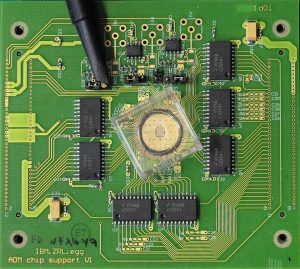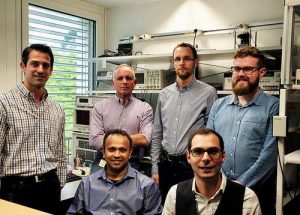IBM Demonstrates In-Memory Computing With One Million Devices for Applications in AI
Running one million phase change memory devices, successfully found temporal correlations in unknown data streams
This is a Press Release edited by StorageNewsletter.com on October 27, 2017 at 2:26 pmFrom: IBM Research Zurich
The IBM researchers used PCM devices made from a germanium antimony telluride alloy, which is stacked and sandwiched between two electrodes.
‘In-memory computing‘ or ‘computational memory’ is an emerging concept that uses the physical properties of memory devices for both storing and processing information. This is counter to current von Neumann systems and devices, such as standard desktop computers, laptops and even cellphones, which shuttle data back and forth between memory and the computing unit, thus making them slower and less energy efficient.
Today, IBM Research is announcing that its scientists have demonstrated that an unsupervised machine-learning algorithm, running on one million phase change memory (PCM) devices, successfully found temporal correlations in unknown data streams. When compared to state-of-the-art classical computers, this prototype technology is expected to yield 200x improvements in both speed and energy efficiency, making it highly suitable for enabling ultra-dense, low-power, and massively-parallel computing systems for applications in AI.
Schematic illustration of in-memory computing algorithm.
Credit: IBM Research
The researchers used PCM devices made from a germanium antimony telluride alloy, which is stacked and sandwiched between two electrodes. When the scientists apply a tiny electric current to the material, they heat it, which alters its state from amorphous (with a disordered atomic arrangement) to crystalline (with an ordered atomic configuration). The IBM researchers have used the crystallization dynamics to perform computation in place.
“This is an important step forward in our research of the physics of AI, which explores new hardware materials, devices and architectures,” says Dr. Evangelos Eleftheriou, IBM Fellow and co-author of the paper. “As the CMOS scaling laws break down because of technological limits, a radical departure from the processor-memory dichotomy is needed to circumvent the limitations of today’s computers. Given the simplicity, high speed and low energy of our in-memory computing approach, it’s remarkable that our results are so similar to our benchmark classical approach run on a von Neumann computer.”
The details are explained in their paper appearing today in the peer-review journal Nature Communications. To demonstrate the technology, the authors chose two time-based examples and compared their results with traditional machine-learning methods such as k-means clustering:
Authors, Nikolaos Papandreou,Evangelos Eleftheriou, Lukas Kull,
Thomas Parnell (back, left to right) and front Abu Sebastian
and Manuel Le Gallo. Missing: Tomas Tuma.
-
Simulated Data: one million binary (0 or 1) random processes organized on a 2D grid based on a 1,000 x 1,000 pixel, black and white, profile drawing of famed British mathematician Alan Turing. The IBM scientists then made the pixels blink on and off with the same rate, but the black pixels turned on and off in a weakly correlated manner. This means that when a black pixel blinks, there is a slightly higher probability that another black pixel will also blink. The random processes were assigned to a million PCM devices, and a simple learning algorithm was implemented. With each blink, the PCM array learned, and the PCM devices corresponding to the correlated processes went to a high conductance state. In this way, the conductance map of the PCM devices recreates the drawing of Alan Turing. (see image above)
-
Real-World Data: actual rainfall data, collected over a period of six months from 270 weather stations across the USA in one hour intervals. If rained within the hour, it was labelled ‘1’ and if it didn’t ‘0’. Classical k-means clustering and the in-memory computing approach agreed on the classification of 245 out of the 270 weather stations. In-memory computing classified 12 stations as uncorrelated that had been marked correlated by the k-means clustering approach. Similarly, the in-memory computing approach classified 13 stations as correlated that had been marked uncorrelated by k-means clustering.
Click to enlarge
“Memory has so far been viewed as a place where we merely store information. But in this work, we conclusively show how we can exploit the physics of these memory devices to also perform a rather high-level computational primitive. The result of the computation is also stored in the memory devices, and in this sense the concept is loosely inspired by how the brain computes.” said Dr. Abu Sebastian, exploratory memory and cognitive technologies scientist, IBM Research and lead author of the paper.
He also leads a European Research Council funded project on this topic.
The IBM scientists will be presenting yet another application of in-memory computing at the IEDM conference in December this year.
Article:Temporal correlation detection using computational phase-change memory
Nature Communications has published an article written by Abu Sebastian, Tomas Tuma, Nikolaos Papandreou, Manuel Le Gallo, Lukas Kull, Thomas Parnell, and Evangelos Eleftheriou, IBM Research–Zurich, Säumerstrasse 4, 8803, Rüschlikon, Switzerland.
The concept of computational memory. a Schematic of the von Neumann computer architecture, where the memory and computing units are physically separated. A denotes information stored in a memory location. To perform a computational operation, f(A), and to store the result in the same memory location, data is shuttled back and forth between the memory and the processing unit. b An alternative architecture where f(A) is performed in place in the same memory location. c One way to realize computational memory is by relying on the state dynamics of a large collection of memristive devices. Depending on the operation to be performed, a suitable electrical signal is applied to the memory devices. The conductance of the devices evolves in accordance with the electrical input, and the result of the operation can be retrieved by reading the conductance at an appropriate time instance
Click to enlarge
Abstract: “Conventional computers based on the von Neumann architecture perform computation by repeatedly transferring data between their physically separated processing and memory units. As computation becomes increasingly data centric and the scalability limits in terms of performance and power are being reached, alternative computing paradigms with collocated computation and storage are actively being sought. A fascinating such approach is that of computational memory where the physics of nanoscale memory devices are used to perform certain computational tasks within the memory unit in a non-von Neumann manner. We present an experimental demonstration using one million phase change memory devices organized to perform a high-level computational primitive by exploiting the crystallization dynamics. Its result is imprinted in the conductance states of the memory devices. The results of using such a computational memory for processing real-world data sets show that this co-existence of computation and storage at the nanometer scale could enable ultra-dense, low-power, and massively-parallel computing systems“.


















 Subscribe to our free daily newsletter
Subscribe to our free daily newsletter

